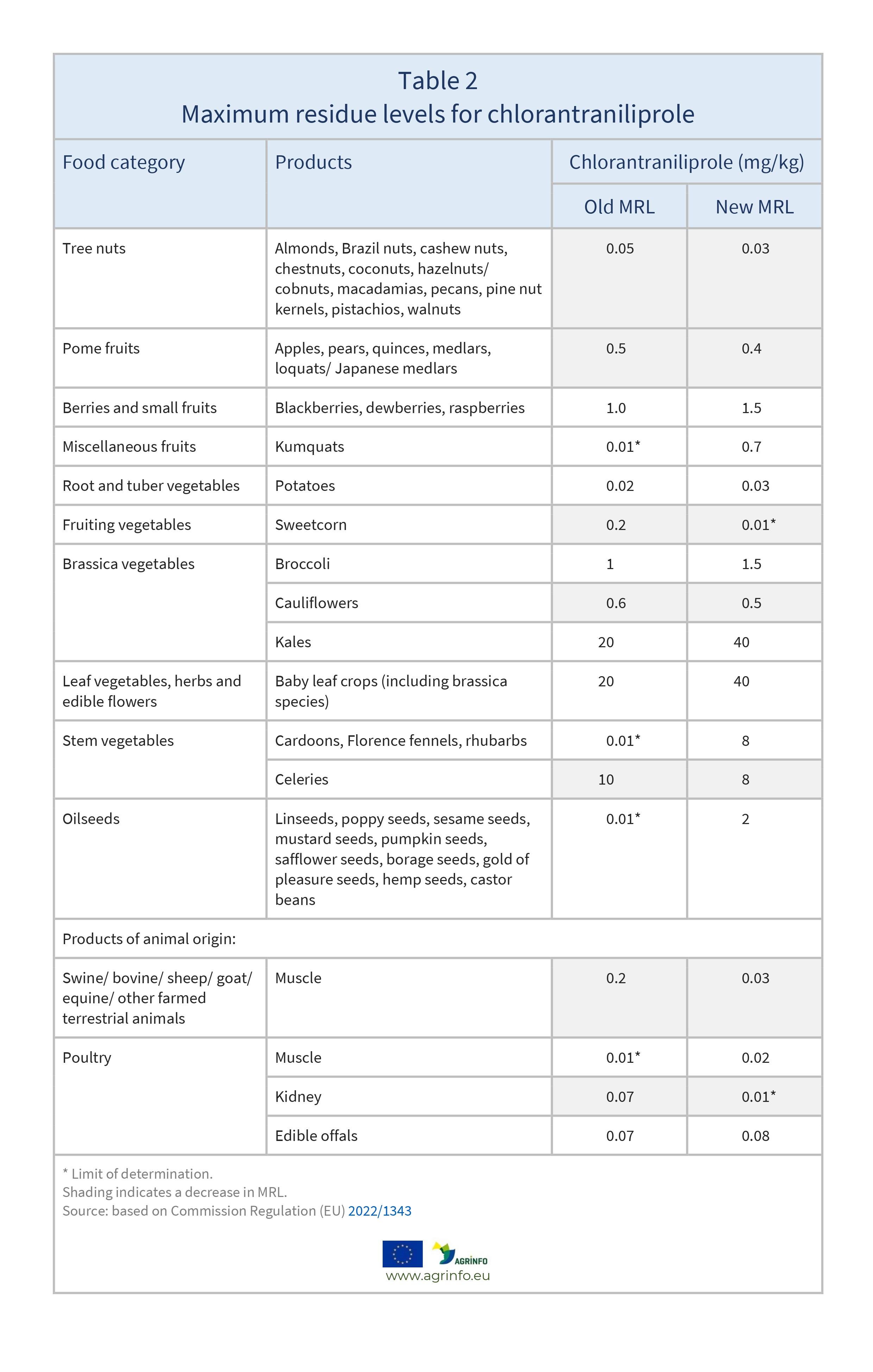Maximum residue levels for chlorantraniliprole
- Pesticide MRLs
Summary
The EU has aligned its maximum residue levels (MRLs) for chlorantraniliprole on avocados and teas with MRLs recently adopted by Codex. This follows earlier changes to the MRLs for this substance that have applied since February 2023.
EU aligns MRLs for chlorantraniliprole on avocados and teas with Codex standards
Commission Regulation (EU) 2022/1343 of 29 July 2022 amending Annexes II and III to Regulation (EC) No 396/2005 of the European Parliament and of the Council as regards maximum residue levels for acequinocyl, chlorantraniliprole and emamectin in or on certain products
Commission Regulation (EU) 2024/1355 of 21 May 2024 amending Annexes II, III and V to Regulation (EC) No 396/2005 of the European Parliament and of the Council as regards maximum residue levels for benzovindiflupyr, chlorantraniliprole, emamectin, quinclorac, spiromesifen, and triflumuron in or on certain products
Update
The EU has aligned its maximum residue levels (MRLs) for chlorantraniliprole on avocados and teas with MRLs recently adopted by Codex. This follows earlier changes to the MRLs for this substance that have applied since February 2023.
Impacted Products
almonds, Brazil nuts, cashew nuts, chestnuts, coconuts, hazelnuts, cobnuts, macadamias, pecans, pine nut kernels, pistachios, walnuts, apples, pears, quinces, medlars, loquats, Japanese medlars, blackberries, dewberries, raspberries, kumquats, potatoes, sweetcorn, broccoli, cauliflowers, cardoons, celeries, Florence fennels, rhubarbs, linseeds, poppy seeds, sesame seeds, mustard seeds, pumpkin seeds, safflower seeds, borage seeds, gold of pleasure seeds, hemp seeds, castor beans, animal products, avocados, teas
What is changing?
The changes to chlorantraniliprole MRLs on avocados and teas are set out in Table 1.
The changes to chlorantraniliprole MRLs that have applied since February 2023 are shown in Table 2.
In addition, the limit of determination (LOD) for coffee beans, sugar beet, and chicory roots has decreased from 0.02 to 0.01 mg/kg; and for herbal infusions, cocoa beans, carobs/ Saint John’s breads, and spices has increased from 0.02 to 0.05mg/kg. (The LOD is the lowest level that can be detected using the most modern and reliable analytical methods.)
Why?
On 2 December 2023, the Codex Alimentarius Commission adopted new Codex maximum residue limits (CXLs) for chlorantraniliprole, for which the European Food Safety Authority (EFSA) did not identify risks to consumers in the EU.
Following its review of existing chlorantraniliprole MRLs, EFSA (2020) recommended lowering MRLs on tree nuts and pome fruits, but raising or maintaining other existing MRLs. Due to insufficient information on various products, these MRLs will be reviewed by July 2024.
Timeline
The new MRLs on avocados and teas set out in Table 1 apply from 11 June 2024.
The MRLs for chlorantraniliprole set out in Table 2 (Regulation 2022/1343) have applied from 22 February 2023.
Background
MRLs are set in accordance with the rules set out in Regulation 396/2005. For information on current MRLs for other substances, please consult the EU Pesticide Residues database.
Resources
EFSA (2020) Review of the existing maximum residue levels for chlorantraniliprole according to Article 12 of Regulation (EC) No 396/2005. EFSA Journal, 18(9): 6235.
EFSA (2023) Scientific support for preparing an EU position in the 54th Session of the Codex Committee on Pesticide Residues (CCPR). EFSA Journal, 21(8): 1–303.
Sources
Commission Regulation (EU) 2022/1343 as regards maximum residue levels for acequinocyl, chlorantraniliprole and emamectin in or on certain products
Commission Regulation (EU) 2024/1355 as regards maximum residue levels for benzovindiflupyr, chlorantraniliprole, emamectin, quinclorac, spiromesifen, and triflumuron in or on certain products
Tables & Figures

.

Disclaimer: Under no circumstances shall COLEAD be liable for any loss, damage, liability or expense incurred or suffered that is claimed to have resulted from the use of information available on this website or any link to external sites. The use of the website is at the user’s sole risk and responsibility. This information platform was created and maintained with the financial support of the European Union. Its contents do not, however, reflect the views of the European Union.
EU aligns MRLs for chlorantraniliprole on avocados and teas with Codex standards
Commission Regulation (EU) 2022/1343 as regards maximum residue levels for acequinocyl, chlorantraniliprole and emamectin in or on certain products
Commission Regulation (EU) 2024/1355 as regards maximum residue levels for benzovindiflupyr, chlorantraniliprole, emamectin, quinclorac, spiromesifen, and triflumuron in or on certain products
What is changing and why?
The EU has aligned its maximum residue levels (MRLs) for chlorantraniliprole on avocados and teas with the MRLs adopted by Codex (see Table 1). This follows earlier changes to the MRLs for this substance that have applied since February 2023 (see Table 2).
Timeline
The new MRLs on avocados and teas set out in Table 1 apply from 11 June 2024.
The MRLs for chlorantraniliprole set out in Table 2 (Regulation 2022/1343) have applied from 22 February 2023.
Tables & Figures

.

Disclaimer: Under no circumstances shall COLEAD be liable for any loss, damage, liability or expense incurred or suffered that is claimed to have resulted from the use of information available on this website or any link to external sites. The use of the website is at the user’s sole risk and responsibility. This information platform was created and maintained with the financial support of the European Union. Its contents do not, however, reflect the views of the European Union.
